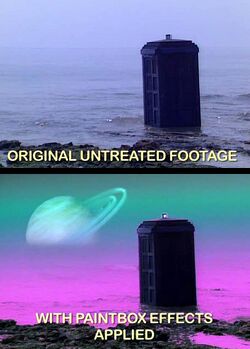Quantel Paintbox
The Quantel Paintbox, or simply Paintbox, was a graphics workstation which revolutionised the way television graphics were produced in the 1980s. Typically of greatest utility to sports and news programming, Paintbox was occasionally repurposed by the British Broadcasting Corporation and used for dramatic and entertainment programming as well. Doctor Who was one of the system's earliest and most enthusiastic adopters in the BBC's Drama Series department.
Though mainly used to superimpose things like lower thirds and other textual elements, it could be used to superimpose anything on any part of the picture. Paintbox also allowed for an early form of colour grading. Though many of the serials in the Sixth and Seventh Doctors' eras used Paintbox to varying degrees, one of the stories to make obvious use of the technology was Mindwarp. Its "making of" documentary demonstrated the effects that Paintbox could accomplish in the mid-1980s.
Still, because the BBC was a very early adopter of the technology, Doctor Who was able to make use of it for the first time on The Leisure Hive, a serial in production at more or less the time the Paintbox workshop first hit the market. Thus, Tom Baker was the first Doctor to be "Paintboxed", and indeed the episode one cliffhanger of Leisure Hive would not have been possible at that time without the Quantel.

